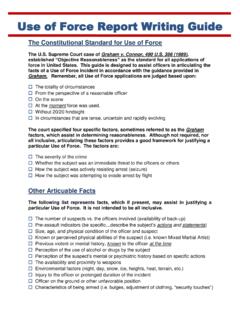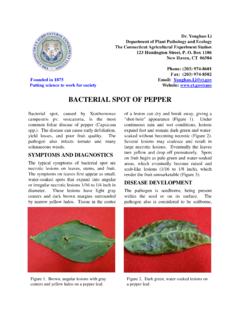Transcription of Civil Liability for the Use of Pepper Spray (OC), Tear Gas ...
1 101 AELE Home P age --- Publications Menu --- Seminar Infor mation ISSN 1935-0007 Cite as: 2014 (5) AELE Mo. L. J. 101 Civil Liability Law Section May 2014 Civil Liability for the Use of Pepper Spray (OC), Tear Gas, and Chemical Agents Part 1 (Last month): Introduction Use by Law Enforcement Use on Handcuffed Persons Warnings Crowds and Bystanders The Aftermath of Their Use New Orleans Police Consent Decree Part 2 (This month): Correctional Settings OC Justified Passive Exposure Decontamination Policy Suggestions for Police and Corrections Resources and References This is Part 2 of a two-part article.
2 To read Part 1, click here. Correctional Settings When force is used in a correctional context, the Fourth Ame ndment s reasonable standard does not apply. Instead, under Whitley v. Albers, #84-1077, 475 312 (1986) and Hudson v. McMillian, #90-6531, 503 1 (1992), force is lawful so long as it is applied in a good faith effort to maintain or restore discipline, r ather than maliciously and sadistically to cause har m. This test applies whether the force was used in the context of a major prison distur bance, s uch as a riot, or a lesser disruption. It is tr ue, the Court ackno wledged, that the extent of the injury a prisoner suffers because of the use of force is one factor to be considered in deciding whether the force used was 102 wanton and unnecessary, but there is no requirement to s ho w a significant injury in order to assert a valid Eighth Ame ndment claim.
3 Contemporary standards of decency, the Court reasone d, are always violated in the excessive force context whe n prison officials or employees maliciously and sadistically use force to cause harm, regardless of whether significant injury occurs. The Court f urther ackno wledged that the Eighth Amendme nt does not co ver de minimis (minimal or trivial) uses of physical force in most instances. Both Whitley v. Albers and Hudson v. McMillian involve d the use of force by prison staff members against convicted prisoners. What about the use of OC against pre-trial detainees in detention facilities, jails, or prisons?
4 Detainees are not protected by the Eighth Amendment prohibition o n cruel and unusual punishment. Since they have not been convicted of any offense, they may not be s ubjected to any punishment at all without receiving due process of law. The y are protected in the custodial context against the excessive use of force by the due process clause of the Fo urteenth Ame ndment. In a footnote in Graham v. Connor, #87-6571, 490 386 (1989), the Supreme Court stated that the due process clause protects a pre-trial detainee from the use of excessive force that amo unts to punishment. After conviction, the Eighth Ame ndment serves as the primar y source of substantive protection.
5 In cases .. where the deliberate use of force is challenged as excessive and unjustified. Any protection that substantive due process affords convicted prisoners against excessive force is, we have held, at least redundant, of that pro vide d by the Eighth Amendme nt. Any real distinction between the protection provided to pre-trial detainees and convicted prisoners has been largely blurred o ver the ye ars by the courts, and the legal standard, technical pleading aside, is essentially the s ame. OC J ustified The application of this legal standar d in the correctional context is illustrated by Horne v.
6 Rutledge, #09-17378, 2010 App. Le xis 20564 (Unpub. 9th Cir.), in whic h a federal appeals court r uled that a prisoner asserting a claim for excessive use of force failed to sho w that prison guards acted maliciously and sadistically for the very pur pose of causing him harm whe n using pe pper Spray o n him after he repe atedly refused to comply with orders to cease holding his blanket up to his cell door. Similarly, in Easley v. Dept. of Rehabilitation and Correction, #2009-05277, 2010 Ohio Misc. Lexis 110 (Ct. of Claims), a correctional officer used no more force than necessary against an inmate who kicked his cell door, yelled profanity, refused orders to stop, and 103 threw some object from his bed at the officer.
7 The use of a s hort burst of Pepper spr ay against the prisoner was not excessive under the circumstances. In Scroggins v. Davis, #07-15514, 2009 App. Le xis 21383 (Unpub. 11th Cir.), cert. denied, #09-8488, 130 1711 (2010), a guar d used a burst of oleoresin capsicum ( ) spr ay against a prisoner who made an aggressive mo ve to war d an officer while being escorted from his cell to be searched for contraband. The action took place after the prisoner had also disobe yed a direct order. After the incident, the prisoner was ke pt in four-point restraints for three and a quarter hours. Rejecting claims of excessive force, a federal appeals court found that jail personnel properly regar ded him as a dangerous, high-risk prisoner in light of a past history of escape, and found that the use of the Spray was proper under the circumstances.
8 The court also found no e vidence that the cell where the plaintiff was restraine d was poorly ve ntilated or small, or that the defendant guar ds, who did not try to wash the s pray off of him, kne w that he claimed to be e xperiencing continue d discomfort from the Spray . In Poe v. Texas Dept. of Criminal Justice, #08-20148, 2009 App. Le xis 706 (Unpub. 5th Cir.), the court ruled that a prisoner f ailed to sho w that the force used against him in his cell was e xcessive, or that engaging in f urther discovery wo uld establish that. The e vidence sho wed that the prisoner refused to obey commands to allow guards to secure his cell door properly by releasing control of a food slot in the door, and that he was war ned that his failure to obe y wo uld result in the use of chemic al age nts and the sending of a mo ve team into his cell.
9 When he f ailed to comply, guar ds administered chemic al agents into his cell and the mo ve team forcibly restrained him. Passive Exposure In Flournoy v. Schomig, #09-3610, 2011 App. Lexis 8303 (Unpub. 7th Cir.), an inmate in an Illinois maximum security f acility claime d to have been exposed to fumes at least eight times whe n guards used pe pper s pray against other prisoners. He also claimed that this aggravate d his glaucoma, although he ne ver sought me dical treatme nt for it. He asserted that officers ignored requests, after pe pper s praying incidents, to air out cells. The prisoner failed to establish that the war den kne w that he had been exposed to pe pper Spray fumes or that he s uffered from glaucoma, which was thereby aggr avated.
10 Claims against the war den for deliberate indifference were therefore properly rejected. 104 Decontamination Whether the use of a c hemical age nt against a prisoner is justified, ho we ver, is not the e nd of the legal issues arising from its use. Lawsuits have frequently re volved around contentions that prisoners or detainees were not pro vided with proper me dical attention for the conseque nces of such use, or were not permitted to pro perly clean off the substance used, a major issue at times in the close quarters of prison and jail cells. At times, prisoners who were not involved in a distur bance or disobe ying orders may also be subjected to exposure to chemic al agents being used against prisoners who are.
















